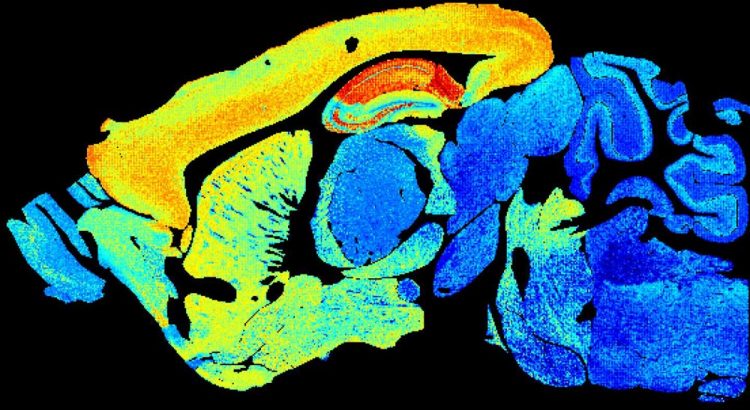Clues to ageing come to light in vivid snapshots of brain cell links

Adult mouse brain section showing increased synapse diversity. Credit Zhen Qui and Seth Grant University of Edinburgh. Credit: Zhen Qui and Seth Grant University of Edinburgh
Findings – published in the journal Science – could shed light on learning disability and dementia and help to reveal how memories are affected by age.
The images are of synapses – vital connections that carry electrical and chemical messages between brain cells. Synapses store memories and synapse damage is linked to more than 130 brain diseases.
Researchers based at the University of Edinburgh colour-coded the different types of molecules to highlight the range of synapses in mouse brains from birth to old age.
They discovered that the number and molecular makeup of synapses shifts with age in different parts of the brain. This happens at three main phases – childhood, middle and elderly age.
Synapse type shifts with age in patterns unique to areas of the brain, blossoming into a diverse array in midlife.
Images from middle-aged brains burst with colour, illustrating a wide variety of synapses. Both very young and very old brain show less synapses and less complexity.
Researchers say these changes give insights into why genes cause synapse damage at set ages and in set brain areas.
The findings could shed light on why we are more likely to develop brain conditions at certain ages, helping to explain why schizophrenia often starts in adolescence, or why dementia affects older adults.
The study was funded by Wellcome and the European Research Council.
Lead researcher, Professor Seth Grant of the Centre for Clinical Brain Sciences at the University of Edinburgh, said: “The brain is the most complex thing we know of and understanding it at this level of detail is a momentous step forward.
“We believe that these findings will be instrumental to helping understand why the brain is susceptible to disease at different times of life and how the brain changes as we age.”
Media Contact
More Information:
http://dx.doi.org/10.1126/science.aba3163All latest news from the category: Life Sciences and Chemistry
Articles and reports from the Life Sciences and chemistry area deal with applied and basic research into modern biology, chemistry and human medicine.
Valuable information can be found on a range of life sciences fields including bacteriology, biochemistry, bionics, bioinformatics, biophysics, biotechnology, genetics, geobotany, human biology, marine biology, microbiology, molecular biology, cellular biology, zoology, bioinorganic chemistry, microchemistry and environmental chemistry.
Newest articles

Silicon Carbide Innovation Alliance to drive industrial-scale semiconductor work
Known for its ability to withstand extreme environments and high voltages, silicon carbide (SiC) is a semiconducting material made up of silicon and carbon atoms arranged into crystals that is…

New SPECT/CT technique shows impressive biomarker identification
…offers increased access for prostate cancer patients. A novel SPECT/CT acquisition method can accurately detect radiopharmaceutical biodistribution in a convenient manner for prostate cancer patients, opening the door for more…

How 3D printers can give robots a soft touch
Soft skin coverings and touch sensors have emerged as a promising feature for robots that are both safer and more intuitive for human interaction, but they are expensive and difficult…





















